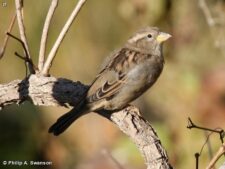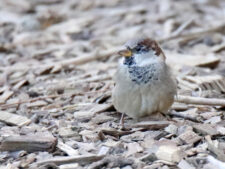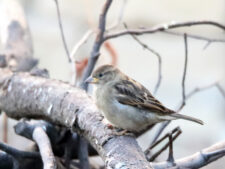
6.25 inches long. The House Sparrow has a thick conical bill and pink legs. The adult male has a gray crown, black throat and upper breast with small mask. There is less black on the throat in the winter. The underparts and side of the neck are grayish. The upperparts and nape are rusty brown with black streaks on the back. There is a white patch in the wing and a gray rump. The bill is black in the summer and yellowish in the winter. The female is much less colored with buffy upperparts with black and tawny streaks and grayish-white unstreaked underparts. There is a buffy line that extends rearward from the eye that is bordered below by a gray brown line. The bill is yellow. Immature birds look like the female.
The House Sparrow is a common year round breeding resident of the Forest.
The House Sparrow is sometimes called the English Sparrow. It prefers to eat seeds and insects. The House Sparrow was introduced in North America in New York City in the 1850s. By the early 20th century it was established across most of the continent. It shows a preference for habitats modified by humans. It is generally considered a nuisance species and an agricultural pest. It is aggressive and noisy. It is a cavity nesting bird and through its aggressiveness displaced many native birds. The song is a twittering series of chirps.
Disclaimer: The content of NatureSearch is provided by dedicated volunteer Naturalists of Fontenelle Forest who strive to provide the most accurate information available. Contributors of the images retain their copyrights. The point of contact for this page is: Phil Swanson.



